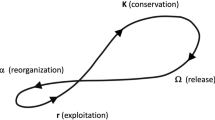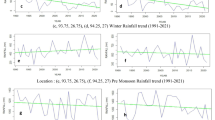Abstract
This article analyzes the effects of increasing urbanization on open space preserves within the metropolitan area of Phoenix, Arizona, USA. Time series analysis is used in 10-year increments over 40 years to study urban landscape change. Three landscape metrics—(1) matrix utility (measures intensity of adjacent land uses), (2) isolation (measures distances to other open space patches), and (3) connectivity (measures physical links to other open space patches and corridors)—are used to assess changes in landscape patterns and serve as indicators of urban ecological integrity of the open space preserves. Results show that in the case of both open space preserves, general decline in indicators of urban ecological integrity was evident. The matrix utility analysis demonstrated that increasing intensity of land uses adjacent to preserve is likely to increase edge effects, reducing the habitat value of interior or core habitat areas. Isolation analysis showed that both preserves have experienced increasing isolation from other open space elements over time. Also, connectivity analysis indicated that terrestrial connections to other open space elements have also deteriorated. Conclusions of this research demonstrate that while preservation of natural areas as open space is important in an urban context, intense development of surrounding areas reduces the urban ecological integrity significantly.





Similar content being viewed by others
References
Ahern J (1995) Greenways as a planning strategy. Landscape and Urban Planning 33:131–155
Arnold CL, Gibbons CJ (1996) Impervious surface coverage. Journal of the American Planning Association 62:243–258
Baker LA, Brazel AJ, Selover N, Martin C, McIntyre N, Steiner FR, Nelson A, Mussachio L (2002) Urbanization and warming of Phoenix (Arizona, USA): impacts, feedbacks and mitigation. Urban Ecosystems 6:183–203
Bartel A (2000) Analysis of landscape pattern: towards a ‘top down’ indicator for evaluation of landscape. Ecological Modeling 13:87–94
Belisle M (2005) Measuring landscape connectivity: the challenge of behavioral landscape ecology. Ecology 86:1988–1995
Benedict T, McMahon R (2006) Green infrastructure. Island Press, Washington, 299 pp
Berling-Wolff S, Wu J (2004) Modeling urban landscape dynamics: a case study in Phoenix, USA. Urban Ecosystems 7:215–240
Bierwagen B (2007) Connectivity in urbanizing landscapes: the importance of habitat configuration, urban area size, and dispersal. Urban Ecosystems 10:29–42
Booth DB, Jackson CR (1997) Urbanization of aquatic systems: degradation thresholds, storm water detection, and the limits of mitigation. Journal of the American Water Resources Association 33:1077–1090
Botequilha Leitao A, Ahern J (2002) Applying landscape ecological concepts and metrics in sustainable landscape planning. Landscape and Urban Planning 59:65–93
Botequilha Leitao L, Miller J, Ahern J, McGarigal K (2006) Measuring landscapes. Island Press, Washington, 118 pp
Bowen GW, Burgess RL (1981) A quantitative analysis of forest island patterns in selected Ohio landscapes. Oak Ridge National Laboratory. Environmental Sciences Division, Oak Ridge, Tennessee, Publication ORNL-TM–7759, 111 pp
Bridgewater PB (1987) Connectivity: an Australian perspective. In: Saunders DA, Arnold GW, Burbidge AA, Hopkins AJM (eds) Nature conservation: the role of remnants of native vegetation. Surrey Beatty, Chipping Norton, Australia, pp 195–200
Briggs MK, Harris L, Howe J, Halvorson W (1996) Using long-term monitoring to understand how adjacent land development affects natural areas: an example from Saguaro National Park, Arizona, USA. Natural Areas Journal 16:354–361
Burke J, Ewan J (1999) The sonoran preserve master plan. Herberger Center for Design Excellence, Arizona State University, Tempe, Arizona, 49 pp
Carroll CR, Noss RF, Paquet PC (2001) Carnivores as focal species for conservation planning in the Rocky Mountain region. Ecological Applications 11:961–980
Cook EA (2002) Landscape structure indices for assessing urban ecological networks. Landscape and Urban Planning 58:269–280
Cook EA, and van Lier HN (eds) (1994) Landscape planning and ecological networks. Elsevier, Amsterdam, Netherlands, 354 pp
Daniel FT, Butterwick ML (1992) Flora of the South Mountains of south-central Arizona. Desert Plants 10:99–119
Dramstadt J, Wenche E, Olson D, Forman RTT (1996) Landscape ecology principles in landscape architecture and land use planning. Island Press, Washington, DC, 80 pp
Erickson D (2006) MetroGreen: connecting open space in North American cities. Island Press, Washington, DC, 333 pp
Ewan J, Underhill M (2003) Exploration of the edge. Herberger Center for Design Excellence, Tempe, 63 pp
Fabos J (1995) Introduction and overview: greenway movement, uses and potentials of greenways. Landscape and Urban Planning. 33:1–13
Fabos J, Ryan R (eds) (2006) Greenway planning around the world. Landscape and Urban Planning 76:1–298
Forman RTT (1995) Some general principles of landscape and regional ecology. Landscape Ecology 10:133–142
Forman RTT (1997) Land mosaics. Cambridge University Press, Boston, MA, 632 pp
Forman RTT, Baudry J (1984) Hedgerows and hedgerow networks in landscape ecology. Environmental Management 8:495–510
Forman RTT, Godron M (1986) Landscape ecology. John Wiley, New York, 619 pp
Gammage G Jr (1999) Phoenix in perspective: reflection on developing the desert. Herberger Center for Design Excellence, College of Architecture and Environmental Design, Arizona State University, Tempe
Gergel SE, Turner MG (2003) Learning landscape ecology. Springer, New York, 316 pp
Gober P, Burns EK (2002) The size and shape of Phoenix’s urban fringe. Journal of Planning Education and Research 21:379–390
Grimm BN, Redman CL (2004) Approaches to the study of urban ecosystems: the case of Central Arizona—Phoenix. Urban Ecosystems 7:199–213
Grimm NB, Grove JM, Pickett STA, Redman CL (2000) Integrated approaches to long-term studies of urban ecological systems. BioScience 50:571–584
Groom MJ, Meffe GK, Carroll RC (2005) Principles of conservation biology, 3rd edn. Sinauer Assoc. Inc., Sunderland, MA, 699 pp
Harris LD (1984) The fragmented forest: island biogeography theory and preservation of biotic diversity. University of Chicago Press, Chicago, IL, 206 pp
Harris LD, Gallager PB (1989) New initiatives for wildlife conservation: the need for movement corridors. In: Macintosh G (ed) Preserving communities and corridors. Defenders of Wildlife, Washington, DC, pp 11–34
Hellmund P, Smith D (2006) Designing greenways. Island Press, Washington, DC, 288 pp
Hess GR, King TJ (2002) Planning open spaces for wildlife I. Selecting focal species using a Delphi survey approach. Landscape and Urban Planning 58:25–40
Hope D, Gries C, Zhu W, Fagan WF, Redman CL, Grimm NB, Nelson A, Martin C, Kinzig A (2003) Socio-economics drive urban plant diversity. Proceedings of the National Academy of Sciences of the United States of America 100:8788–8792
Jones JA, Swanson FJ, Wemple BC, Saunder KU (2000) Effects of roads on hydrology, geomorphology and disturbance patches in stream networks. Conservation Biology 14:76–85
Jongman R, Pungetti G (eds) (2004) Ecological networks and greenways: concept, design, implementation. Cambridge University Press, Cambridge, 345 pp
Kaufman MM, Wigston DL, Perlman EB (2002) Environmental evaluation of subdivision developments. Environmental Management 29:801–812
Keller LF, Waller DM (2002) Inbreeding effects in wild populations. Trends in Ecological Evolution 17:230–241
Keys E, Wentz EA, Redman CL (2007) The spatial structure of land use from 1970–2000 in the Phoenix, Arizona, Metropolitan Area. The Professional Geographer 59:131–147
Knowles-Yanez K, Moritz C, Fry J, Redman CL, Bucchin M, McCartney PH (1999) Historic land use: phase 1 report on generalized land use. Center for Environmental Studies, Arizona State University, Tempe, 21 pp
Kurosawa B, Askins RA (2003) Effects of habitat fragmentation on birds in deciduous forests in Japan. Conservation Biology 17:695–707
Little CE, (1990) Greenways for America. Johns Hopkins University Press, Baltimore, MD, 288 pp
Lowe JC, Moryades S (1975) The geography of movement. Houghton Mifflin, Boston, 442 pp
Luck M, Wu J (2002) A gradient analysis of urban landscape pattern: a case study from the Phoenix metropolitan region, Arizona, USA. Landscape Ecology 17:327–339
Martin CA, Stabler LB (2002) Plant gas exchange and water status in urban desert landscapes. Journal of Arid Environments 51:235–254
McGarigal K, Marks BJ (1995) FRAGSTATS: spatial pattern analysis program for quantifying landscape structure. Gen. Tech. Rep. PNW-GTR-351. US Department of Agriculture, Forest Service, Pacific Northwest Research Station, Portland, OR, 122 pp
Meffe GK, Carroll RC (1994) Principles of conservation biology. Sinauer Assoc. Inc., Sunderland, MA
Merriam G (1984) Connectivity: a fundamental ecological characteristic of landscape pattern. In: Brandt J and Agger P (eds) Proceedings of the 1st international seminar on methodology in landscape ecological research and planning, Theme I: landscape ecological concepts. Roskilde University Centre Book Company, Roskilde, Denmark, pp 5–16
Moilanen M, Nieminen M (2002) Simple connectivity measures in spatial ecology. Ecology 84:1131–1145
Naiman RJ, Decamps H, Pollock M (1993) The role of riparian corridors in maintaining regional biodiversity. Ecological Applications 3(2):209–212
Nassauer JI, Corry RC, Cruse RM (1999) The landscape in 2025 alternative future landscape scenarios: a means to consider agricultural policy. Journal of Soil and Water Conservation 57:44–53
Noss RF (2004) Can urban areas have ecological integrity? In: Shaw WW, Harris K, VanDurff L (eds) Proceedings of the 4th international urban wildlife symposium on urban wildlife conservation, University of Arizona, Tucson, Arizona, pp 2–8
Noss RF, Harris LD (1986) Nodes, networks, and MUMs: preserving diversity at all scales. Environmental Management 10:299–309
Paul MJ, Meyer JL (2001) Streams in the urban landscape. Annual Review of Ecology and Systematics 32:333–365
Pauleit S, Duhme F (2000) Assessing the environmental performance of land cover types for urban planning. Landscape and Urban Planning 52:1–20
Rees LW (1996) Our ecological footprint: reducing human impact on earth. New Society Publication, Philadelphia, 216 pp
Severns P (2003) Inbreeding and small population size reduce seed set in a threatened and fragmented plant species. Biological Conservation 110:221–229
Shafer CL (1994) Beyond park boundaries. In: Cook EA, Van Lier HN (eds) Landscape planning and ecological networks. Elsevier, Amsterdam, Netherlands, pp 201–223
Shafer CL (1999) US national park buffer zones: historical, scientific, social and legal aspects. Environmental Management 23:49–73
Shaw WW, Harris LK, Livingston M (1998) Vegetative characteristics of urban land covers in metropolitan Tucson. Urban Ecosystem 2:65–73
Shen W, Wu J, Grimm NB, Hope D (2008) Effects of urbanization-induced environmental changes on ecosystem functioning in the Phoenix metropolitan region. USA Ecosystems 11:138–155
Soule ME (1991) Land use planning and wildlife maintenance: guidelines for conserving wildlife in an urban landscape. Journal of the American Planning Association 57:313–323
Stabler LB, Martin CA (2004) Irrigation and pruning affect growth and water use efficiency of two desert adapted shrubs. Acta Horticulturae 638:255–258
Steiner F (2000) The living landscapes: an ecological approach to landscape planning, 2nd edn. McGraw-Hill, New York, 477 pp
Taylor PD, Fahrig L, Henein K, Merriam G (1993) Connectivity is a vital element of landscape structure. Oikos 68:571–573
Taylor PD, Fahrig L, With AK (2006) Landscape connectivity a return to the basics. In: Crooks KR, Sanjayan M (eds) Connectivity conservation. Cambridge University Press, Cambridge, UK, pp 29–43
Thibault PA (1997) Ground cover patterns near streams for urban land use categories. Landscape and Urban Planning 39:37–45
Wegner JF, Merriam G (1979) Movements by birds and small mammals between a wood and adjoining farmland habitats. Journal of Applied Ecology 16:349–357
Wilcox BA (1980) Insular ecology and conservation. Trends in Ecology & Evolution 1:46–48
Wu J, David JL (2002) A spatially explicit hierarchical approach to modeling complex ecological systems: theory and applications. Ecological Modelling 153:7–26
Wu J, Hobbs RJ (2006) Key topics in landscape ecology. Cambridge University Press: Cambridge, 314 pp
Yabes R, Shetter K, Schneeman J (1997) Urban waterways: changing uses and users in a southwestern city. Landscape and Urban Planning 39:167–185
Yu X, Ng J (2006) An integrated evaluation of landscape change using remote sensing and landscape metrics. International Journal of Remote Sensing 27:1075–1096
Acknowledgments
The authors are grateful to the staff of the City of Phoenix Parks and Recreation Department for sharing invaluable information with regards to the mountain preserves and to Landiscor Aerial Photography for providing the aerials. The authors also greatly appreciate the thorough review of three anonymous reviewers and their comments that helped improve this manuscript.
Author information
Authors and Affiliations
Corresponding author
Rights and permissions
About this article
Cite this article
Esbah, H., Cook, E.A. & Ewan, J. Effects of Increasing Urbanization on the Ecological Integrity of Open Space Preserves. Environmental Management 43, 846–862 (2009). https://doi.org/10.1007/s00267-009-9274-z
Received:
Revised:
Accepted:
Published:
Issue Date:
DOI: https://doi.org/10.1007/s00267-009-9274-z




